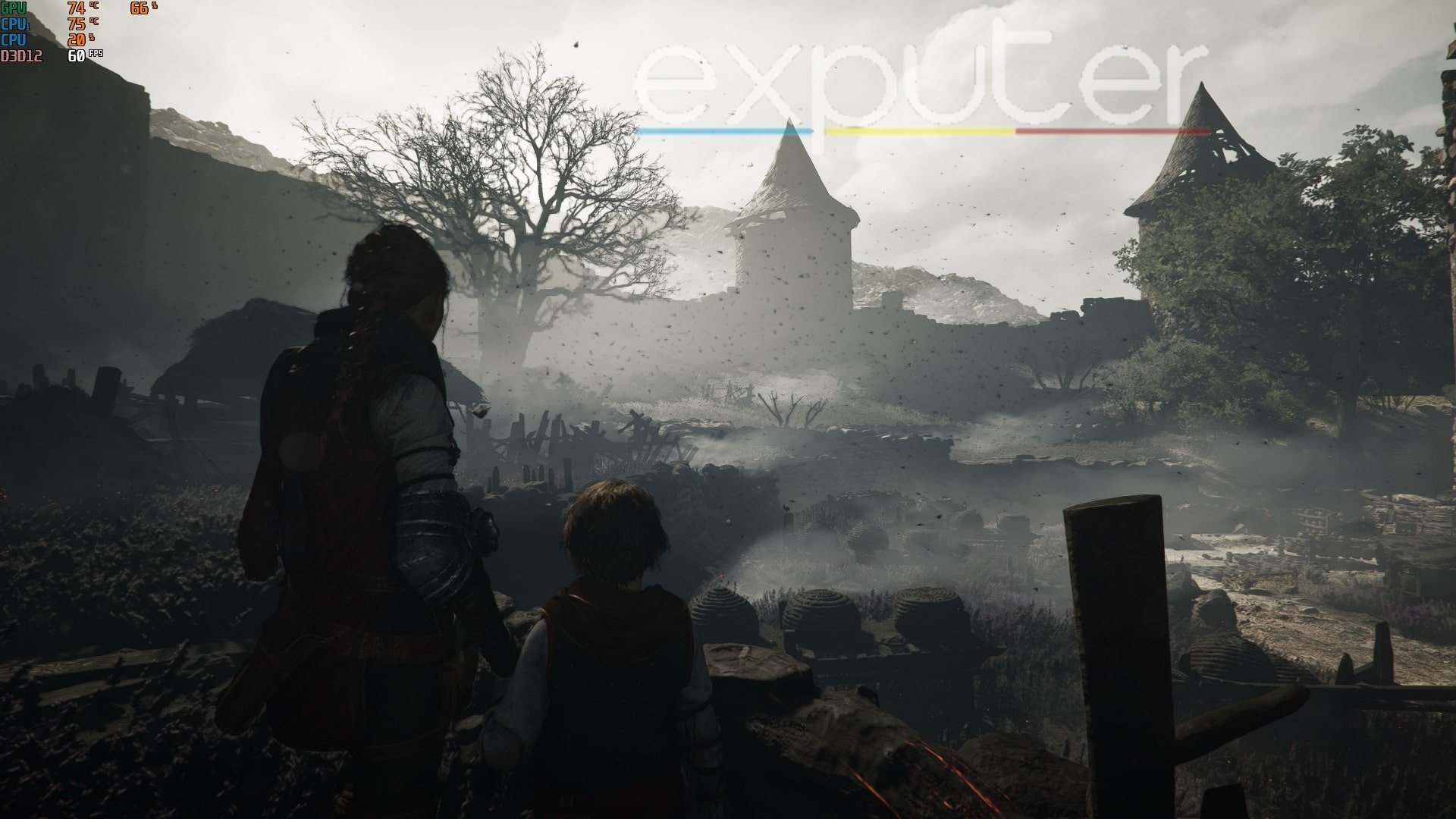This rat-infested game is the sequel to the critically acclaimed A Plague Tale Innocence, which was one of the best surprises of 2019. And now, after a long wait, the highly anticipated sequel is finally out, so we have prepared a detailed A Plague Tale Requiem review for you today.
This is a complete next-gen title that is only available across the PS5, Xbox Series X/S, and PC. That said, having played the first game two times and happily reaching 100% completion on both occasions, the sheer anticipation of A Plague Tale Requiem and being able to review it after such a long wait was equally feel-good and satisfying, to say the least.
- Developer: Asobo Studio
- Publisher: Focus Entertainment
- Release Date: October 17, 2022
- Platforms: Nintendo Switch, Playstation, Xbox and PC
- Predecessor: A Plague Tale: Innocence
Story And Setting

The two siblings are back once again as Amicia is thrown into another rollercoaster of a journey where she needs to discover the cure for her little brother, Hugo, as he continues to be plagued and haunted by the dark magic known as the Macula. As was seen in the events of the first game, this power allowed him to channel a deep connection between the infesting rats that devoured France and ultimately allowed both siblings to overcome the threats of The Inquisition.
However, happy endings don’t last too often. Leaving some things unchecked, both Amicia and Hugo, as well as their friend, Lucas, and their Mother, Beatrice, find themselves investigating deeper secrets involving the Macula and the lust for power behind it that can destroy Hugo. Both of the siblings must now venture across new landscapes and treacherous zones as they unearth secrets related to the dark magic, as well as battle new malicious foes who intend to kidnap the younger for their evil schemes.
As mentioned previously, a few side characters make a return, such as Lucas, who is the apprentice of the doctor you meet during the events of the first game. Alongside these familiar casts of characters, you will meet newer ones such as Sophia, an enthusiastic pirate who will provide a stark cheeriness to the gritty narrative of the game, as well as Arnaud, a former knight who now commands a group of rebellious mercenaries.
What I loved the most about this sequel is the more prominent characterization here than in the previous game, as it centered more on the crumbling traits of Amicia as she battles with her inner demons. It may sound a little too complex, but if you’ve played the first game then you will know about the bond between the two siblings, and with Requiem, it takes their relationship even further than you could imagine.

You begin to slowly witness the mental toll Amicia is experiencing as no matter how much she does to protect anyone, more evil follows, causing her to grow more obsessive and paranoid about protecting her brother at all costs.
It is possibly one of the highlights for me during my review of A Plague Tale Requiem, as it was gut-wrenching but equally heartwarming to see her character have a bigger focus in the narrative. A lot of child characters in narrative-heavy titles, such as Hugo, may come off as annoying at first glance. But contrary to initial impressions, he is easily one of the most endearing characters in the game, and he never outstays his welcome.
Even during the most gruesome scenarios, you see that Hugo has grown accustomed to staying composed along with his sister since the first game. And during out-of-combat moments, you can take your time immersing yourself in the world and enjoy some wholesome quality bonding time with the siblings.
Gameplay

Despite being a full-fledged sequel the gameplay largely remains the same, while the main improvement comes in the form of larger-level designs that emphasize verticality and multiple layers. Perhaps the best aspect is that the game is now broken down into parts where you must navigate across torn battlefields and militia-controlled zones while you constantly visit towns and villages at other times. The latter will provide fresh air for those who will get tired of the brutal stealth-action gameplay.
For those who are new to the series, the gameplay of the title revolves around mainly using Amicia for the combat portions as she can use her sling and a variety of other makeshift tools to tackle enemies as well as carefully making use of the environment in order to traverse rat-infested areas. Meanwhile, Hugo is able to act as the nimble yet powerful force of integrity as he can crawl through narrow spaces and assist his sister in various different ways during puzzles, stealth sections, or even fights.

Most importantly, Hugo is now able to command the swarms of Rats at will, as was seen during the 2nd half of the first game. Compared to his previous run with these powers, he is able to use them at a much more stable pace in Requiem, allowing him to conjure a bunch of rats at long distances to take down enemies as he sees fit. Amicia is also able to interact with her environment as she can go prone under tables and other architectural aspects of the levels, making them feel more meaningful rather than just being a part of the setting.
Both of the siblings feature the same general style of gameplay, but it is much more polished this time around as Stealth mechanics have been tweaked significantly in accordance to be in line with the larger scope of the gameplay. However, some players may find the quality and pacing to be really methodical, as some of the stealth-focused encounters seem forced onto the player, whereas previously you could clear most of those instances without engaging with the enemies at all.

But of course, the game wouldn’t be complete if it didn’t have its own sets of action sequences which will easily send you on an adrenaline frenzy as you get chased by an army of rats or take down multiple soldiers using Amicia. She may be sturdy and experienced this time around, but if enemies can overwhelm you at any given point, she will fall to them in a heartbeat causing you to restart from the last checkpoint. Luckily the new counter mechanic allows you to escape close combat engagements with ease, one of my new favorite additions to the game.
There are also new passive skills that players can unlock for Amicia and they have a unique twist so that you can acquire each through different methods. You will essentially have to incorporate different types of playstyles while completing the combat encounters in the game, which in turn will reward you with threshold points for each skill category. These skills are broken down into Prudence, Aggressive, and Opportunism, which will gradually fill up if you manage to take down enemies via stealth, melee, or tactically using the alchemy tools of Amicia such as the Ignifier.

Players jumping into the game for the first time should keep in mind to use every bit of artillery available to Amicia in order to take down their opponents.
Properly exploring the levels is also key, as you will need to locate every ounce of resources available to you in order to craft more ammunition for your tools and slings. Furthermore, take your time getting used to Hugo, as his rat-controlling abilities will be the trump card to winning the larger ambush encounters and military encampments.
Lastly, compared to the linear design of the first game, stay vigilant as you can potentially miss some valuable collectibles while on your way through the main campaign. A Plague Tale Requiem constantly surprised me with its clever and creative puzzle design, and these challenges never overstay their welcome. But when they pose as a roadblock to acquiring certain items or complete objectives, that is when they can feel like a drag. Hopefully, it shouldn’t cause too many problems for someone who enjoys these elements wholeheartedly.
Performance And Visuals

A Plague Tale Requiem will amaze players with its life-like visuals, and photorealistic character designs that make you question whether this is actually a AAA title. The environments are densely packed with foliage and other details that make the countryside areas of France feel alive and rich. Compared to the first game, Requiem personifies its characters a lot more as the facial expressions during some of the dialogue scenarios are smoother and cinema-like than in the first game, where they sometimes came across as robotic.
However, despite having a high graphic fidelity, it is fair to acknowledge that the game is currently suffering from a ton of performance issues even with the best PC setups. I played the game on my RTX 3060 Ti along with a Ryzen 5 3600, and it’s safe to say that despite having DLSS turned on, there were plenty of moments where the game stuttered during combat encounters and in highly populated areas.

Not to mention, the game hardly even utilizes CPU and GPU usage, thus adding more to the fact that the game desperately needed optimization fixes. Furthermore, another important thing is that the title is seemingly locked at 30 FPS across PS5 and the Xbox consoles, meaning that there is no option to enable a proper performance mode where it optimizes the framerate. It is unclear whether or not the developers had intended this since it is causing major frustration and backlash from the community.
Thankfully, the only saving grace here is that Nvidia RTX series users like myself shouldn’t face too many worries as with the DLSS rendering API, you should be able to run the game at High to Ultra settings with settings such as Shadows and Draw Distance toned down in order to face fewer of the known issues. But both the Nvidia GTX and AMD GPU users are thrown in the mud as the game lacks the FSR rendering API, which can highly improve performance for the game to make it applicable to run on-budget PC builds.
There is no certainty yet on when Focus Entertainment will respond to the performance controversy of the game, but for now, the only option for every player is to wait it out until they can provide feedback on the fixes. Aside from that, it comes off as a huge shock to the player base as there was no aforementioned news before release by the developers that the game would be locked at the graphical setting of 30 FPS and 1440p on consoles.
But it is safe to say that the plague of horrendous framerate was far more traumatizing than the 300,000 rats being rendered on the screen. Now let’s wrap up this review of A Plague Tale Requiem as we discuss our final verdict.
Verdict

This has been our A Plague Tale Requiem review, and it has been one of my most highly anticipated games of the year. And despite suffering from major performance issues, the game is an absolute delight to play from start to finish. Seeing Amicia and Hugo again felt like reuniting with your best friends after a long time, as their dynamic never ceases to impress you with their wholesome yet emotional relationship.
The back-and-forth conflicts between each of them will leave you reeling and asking what’s going to happen next, and with such a high-stakes finale, you will be on the edge of your seat as you witness a conclusion to yet another thrilling tale of these two siblings in such a gruesome world. The gameplay and stealth mechanics have been refined thanks to the improved controls, and players will also notice a bunch of new accessibility options compared to its predecessor.
However, in the current state, there is a debate to be had on whether the game is worth it or not with its insufferable performance and stuttering problems. Nonetheless, It is still a testament to the power of linear open-world games that have a significant focus on coherent narrative-driven experiences, and if you’re looking specifically for that kind of game, look no further than A Plague Tale Requiem.
This wraps up our A Plague Tale Requiem review, and we hope it helps you decide whether the game is worth buying in its current state or not. Be sure to check out some of our other reviews:
Thanks! Do share your feedback with us. ⚡
How can we make this post better? Your help would be appreciated. ✍
A Plague Tale: Requiem Review
Overall
-
Story And Setting
-
Gameplay
-
Performance And Visuals
Verdict
A Plague Tale Requiem had been one of my most highly anticipated games of the year, and despite suffering from major performance issues, the game is an absolute delight to play from start to finish.
Pros
- Captivating Storytelling.
- Enthralling Characters And Performances.
- Beautifully Designed World.
- Multi-Faceted Level Design.
Cons
- Combat Remains Mostly The Same.
- Intolerable Performance Issues.
- Lackluster Enemy Variety.



